Ijraset Journal For Research in Applied Science and Engineering Technology
- Home / Ijraset
- On This Page
- Abstract
- Introduction
- Conclusion
- References
- Copyright
Comprehensive Performance Analysis of Hybrid Solar Water Heating Systems: Synergizing Photovoltaic and Thermal Technologies
Authors: Mohammad Naushad Alam, Prof. Amit Agrawal
DOI Link: https://doi.org/10.22214/ijraset.2024.63577
Certificate: View Certificate
Abstract
Solar water heaters are an efficient and sustainable technology for meeting the growing demand for hot water in residential and commercial applications. This abstract presents a comprehensive overview of the performance evaluation of solar water heater systems through an extensive experimental study. The study aims to assess the effectiveness and efficiency of different solar water heater configurations under varying operating conditions. The experimental investigation involved the measurement and analysis of key performance parameters such as solar collector efficiency, heat transfer efficiency, thermal storage capacity, and overall system efficiency. A range of factors including solar radiation intensity, ambient temperature, water flow rate, and collector tilt angle were systematically varied to examine their impact on system performance. The results of the experimental study demonstrated the significant potential of solar water heaters in providing cost-effective and environmentally friendly hot water solutions. The solar collector efficiency was found to be highly influenced by the solar radiation intensity, with higher levels of solar irradiation leading to increased thermal energy generation. The heat transfer efficiency was optimized by adjusting the water flow rate and collector tilt angle, ensuring efficient transfer of heat from the collector to the water. Furthermore, the thermal storage capacity of the system played a crucial role in maintaining a consistent supply of hot water during periods of low solar radiation or high demand. Overall system efficiency was found to be strongly dependent on the integration of efficient heat exchangers and insulation materials. Based on the experimental findings, recommendations for system design and optimization were formulated, highlighting the importance of proper sizing, selection of suitable materials, and appropriate control strategies. The results also identified areas for future research, such as the integration of advanced heat transfer enhancement techniques and the utilization of hybrid solar water heater systems.
Introduction
I. INTRODUCTION
The sun generates solar energy by harnessing its hydrogen atoms through fusion reactions. These reactions produce highly energetic gamma rays, a type of electromagnetic radiation, which travel from the sun to the Earth, covering a distance of 150 million km. Among various types of electromagnetic radiation, such as infrared, visible light, and ultraviolet, solar energy that reaches the Earth's surface can be directly captured using photovoltaics (solar cells) and solar concentrators. Solar concentrators convert sunlight into heat energy, while photovoltaics generate electricity. Solar water heating technology utilizes solar energy collectors (concentrators) to convert radiation into heat energy. A basic solar water heater typically includes a flow path for the working fluid, a collector, and a storage tank.
Historical records indicate that the concept of a solar water heater (SWH) originated in the Roman Empire around 200 AD. The Romans used a simple method to heat their public baths, aiming to conserve coal and reduce labor by harnessing the principle of solar heating. Although these early devices were not fully self-sufficient, they laid the foundation for the development of solar water heating. The idea of utilizing the sun for water heating was largely forgotten for over a thousand years following the fall of the Roman Empire. It was reintroduced in the late 18th century by Swiss naturalist De Saussure. He constructed an insulated box with two glass panes, painting its bottom black to maximize solar radiation absorption. This design served as the prototype for all subsequent solar water heaters. De Saussure's experiments demonstrated that the interior of the insulated box reached temperatures higher than the boiling point of water when exposed to sunlight, thus illustrating the greenhouse effect for the first time.
While De Saussure believed his innovative mechanism would be valuable to scholars, it took more than a century for widespread recognition and adoption of solar water heating technology to occur.
II. THE POTENTIAL OF SOLAR ENERGY FOR HEATING WATER
The Earth receives a tremendous amount of solar energy in a single day, surpassing the total energy consumption of humanity. In comparison to the Earth's reserves of natural gas, coal, and oil, just 18 days of incoming solar radiation would yield a similar energy output. Beyond the Earth's atmosphere, there is an abundance of solar energy, with approximately 1,300 watts per square meter. However, when this energy enters the Earth's atmosphere, about one-third of it is reflected back into space, while the remaining portion continues toward the Earth's surface. On average, each square meter of the Earth's surface receives approximately 4.2 kilowatt-hours of solar energy per day [3].
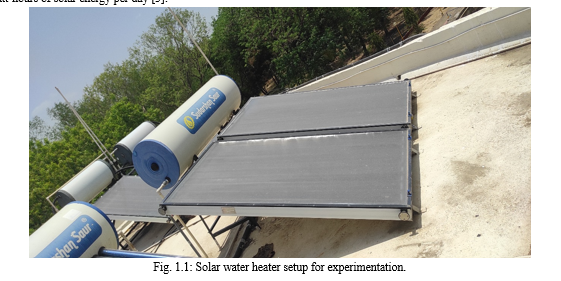
Scientists carefully monitor the levels of solar energy that reach specific regions at various times of the year. These measurements serve as a basis for estimating the amount of incident solar radiation in other locations with similar latitudes and climates. Solar energy measurements are typically presented in two forms: the total solar radiation on a horizontal surface or the total solar radiation on a surface that tracks the movement of the sun. These measurements allow researchers to quantify and compare the availability of solar energy across different geographical areas and climates.
III. SOLAR RADIATION AT THE SYSTEM LOCATION
Selecting a suitable geographical location is crucial when planning a solar-powered system. The performance of any solar system heavily relies on the amount of solar radiation, known as insolation, received at the site. Since insolation levels vary across different geographic locations, understanding the local meteorology is essential for designing an efficient solar system. In the case of city, it is situated in the northern region of the country, with latitude coordinates of 9.0765° N and 7.3986° E. Due to factors such as proximity to the Sahara Desert, the northern states of Nigeria generally experience higher levels of insolation [4]. This knowledge of regional insolation patterns helps optimize the design and performance of solar-powered systems in Abuja and similar locations.
IV. THERMOSYPHON PRINCIPLE-BASED SWH OPERATING PRINCIPLES
When sunlight shines on the solar collector's transparent cover, the black-coated metallic plate within the collector absorbs the solar radiation as heat. This absorption of solar energy increases the internal energy of the metallic plate, causing the temperature of the solar collector to rise. The working fluid, closely connected to the black-coated metallic plate through a piping system, absorbs this heat energy. As the working fluid absorbs the heat, it expands, leading to a decrease in its density. Based on the thermosyphon principle, gravity causes the colder fluid from the storage tank to flow into the collector, while the heated fluid rises naturally through the pipes at the top of the collector and returns to the storage tank.
This process continues until the water in the storage tank reaches the desired temperature, with the hot water being transferred due to the increase in both volume and temperature. To control the temperature, the valves can be manually closed once the desired temperature is achieved, or the cycle can be regulated by a thermostat. A typical flat-plate collector, as illustrated in Figure 2.1, demonstrates this configuration.
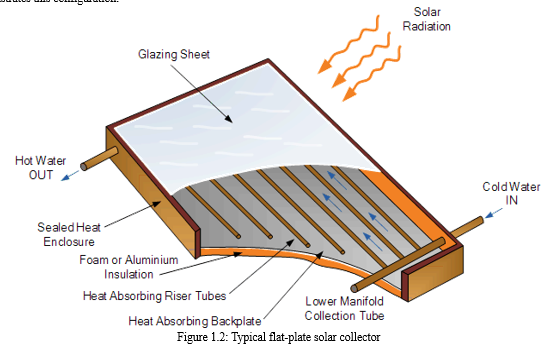
V. TYPES OF SOLAR WATER HEATING SYSTEMS
Solar water heating systems can be categorized as either passive or active, depending on how the heat transfer fluid is circulated within the system. The heat transfer fluid can be water or an antifreeze substance. In a passive system, the movement of water or the heat-absorbing fluid is achieved through natural convection and the force of gravity. This means that no electrical pump is required for fluid circulation within the system.
On the other hand, an active system utilizes an electric pump to facilitate the movement of the working fluid throughout the solar water heating system [6]. The pump actively circulates the heat transfer fluid, ensuring efficient heat transfer from the solar collector to the storage tank or point of use. This active circulation method provides greater control over the flow rate and enables the system to operate effectively even in situations where natural convection is limited. Both passive and active systems have their advantages and considerations, and the choice between them depends on factors such as system size, efficiency requirements, and the specific conditions of the installation site.
A. Passive System
Passive systems for solar water heating do not require the use of pumps to circulate the working fluid; instead, they rely on natural forces and the laws of physics. These systems are characterized by their simplicity, which translates into lower costs, higher reliability, reduced maintenance requirements, and potentially longer lifespans compared to active systems. However, it is important to note that passive systems generally exhibit lower efficiency levels compared to their active counterparts.
There are two main categories of passive solar water heating systems: the thermosyphon system and the batch or integral-collector system [6]. In a thermosyphon system, the working fluid circulates naturally through the system, driven by the principles of convection and gravity. The heated fluid rises and flows into the storage tank, while cooler fluid descends to replace it, creating a continuous circulation loop.
On the other hand, the batch or integral-collector system involves a single, integrated unit where both the solar collector and storage tank are combined. Water is heated directly within this unit, and as it gains heat energy, it rises to the top of the unit.
The heated water is then drawn for use, while cooler water enters to take its place, initiating the heating cycle. Passive systems offer advantages in terms of cost, reliability, and maintenance, but they come with trade-offs in terms of efficiency. The choice between passive and active systems depends on specific requirements, budget constraints, and the desired performance of the solar water heating system.
B. Batch System
The integral-collector storage system, also known as an ICS system, is a configuration where one or more storage tanks, coated in a black material, are enclosed within an insulated box topped with glass The water within the tank is heated and subsequently transferred from the tank to the desired destination using either gravity or natural convection, which is the tendency of hot fluids to
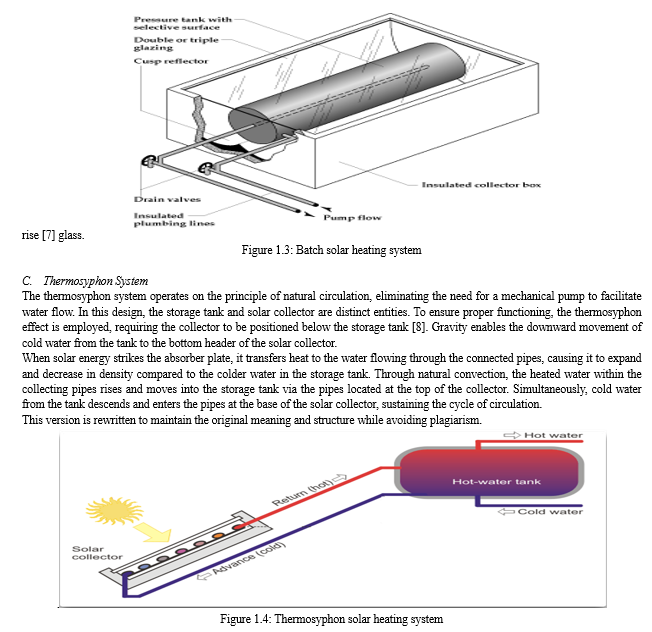
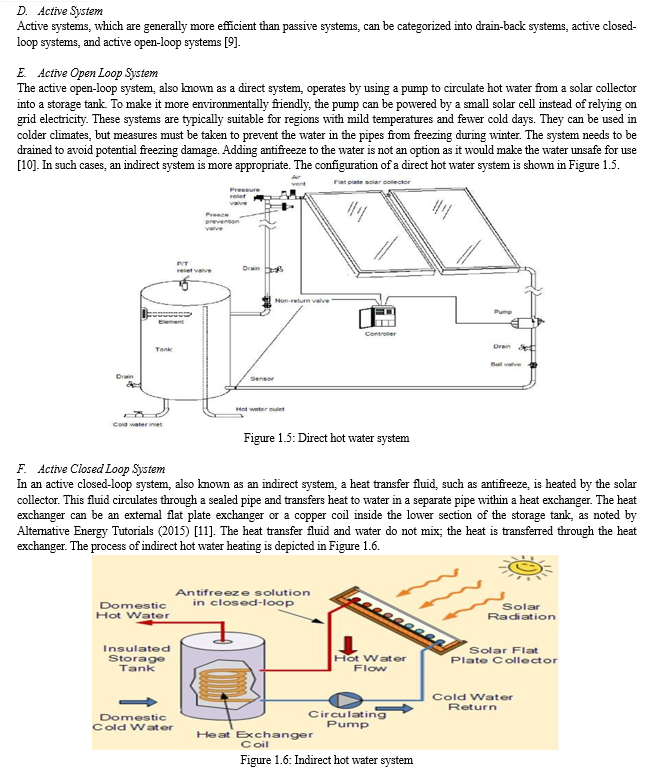

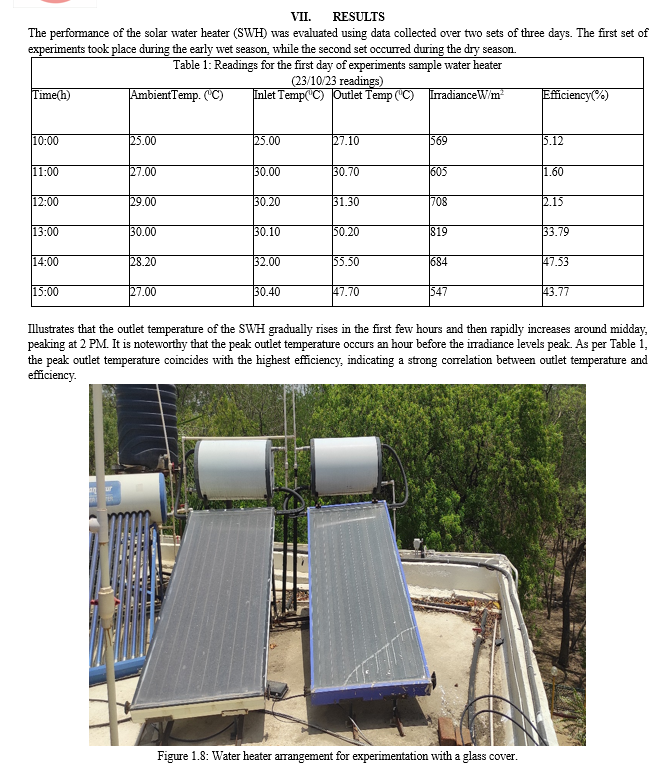
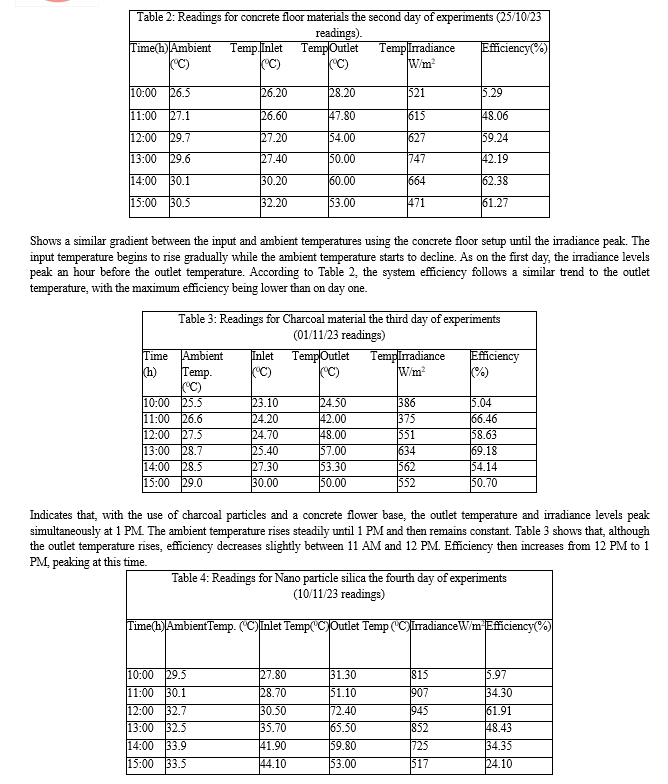
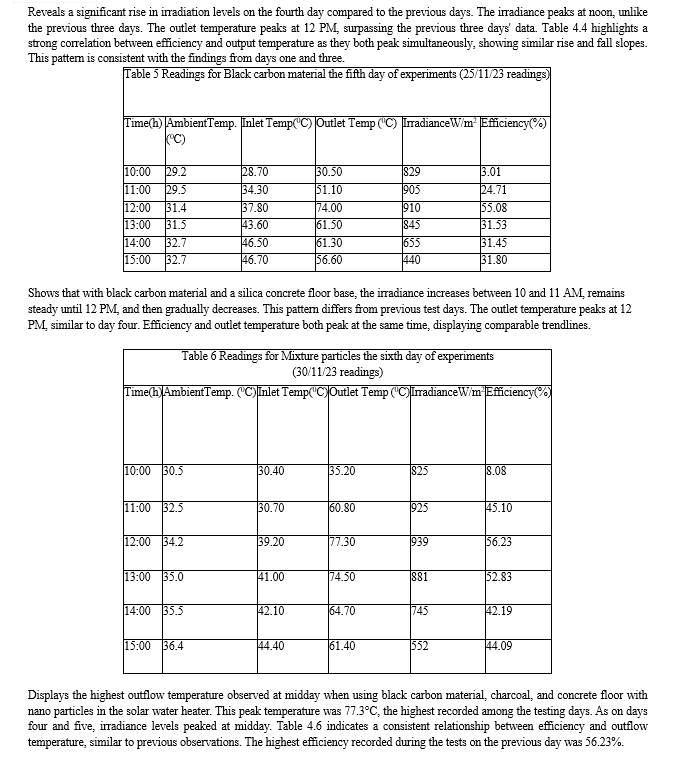
Compares the outlet temperatures for the six days of testing. There is a notable difference between the temperatures recorded during the late rainy season (days one to three) and the dry season (days four to six). During the late rainy season, the peak outflow temperature occurred between 1:00 PM and 2:00 PM, while in the dry season, the peak was at midday. This clearly indicates that the system operates more efficiently in the dry season.
VIII. DISCUSSION OF RESULTS
The experiments show that a combination of nanoparticles, black carbon material, and a concrete floor yielded the best performance, with a strong correlation between output temperature and irradiation levels. The highest recorded outlet temperature during the late rainy season was 57.0°C, while during the dry season it was 77.3°C. This demonstrates the system's superior performance during dry conditions.
The system, designed with a target output temperature of 70°C and a collector area of 0.76 m², successfully heated 36 liters of water but did not meet the goal of 75 liters at 60°C daily. Comparatively, another study with a collector area of 1.464 m² achieved a maximum output temperature of 77.3°C on a surface area of 2.3 m². Despite their larger collector area, their peak outlet temperature was slightly lower, emphasizing the impact of collector area and site irradiance on performance. The highest irradiation level recorded was 936 W/m², coinciding with the maximum outflow temperature of 77.3°C on the sixth day. The most significant temperature increase occurred between 13:00 AM and noon on the fourth day, with a rise of 75.5°C. Day three exhibited the lowest irradiance levels. The system performed optimally on day four, achieving an efficiency of 69.18%
IX. FUTURE PERSPECTIVES
To build upon the findings of this study, future research could focus on:
- Long-term Performance Monitoring: Conducting extended performance monitoring to understand the hybrid system's durability and maintenance requirements over time.
- Technological Innovations: Exploring advancements in PV and thermal technologies that could further enhance the efficiency and cost-effectiveness of hybrid systems.
- Scalability and Applications: Investigating the scalability of hybrid systems for larger applications, such as commercial buildings or industrial processes, and assessing their performance in diverse climatic conditions.
- Economic Incentives: Evaluating the impact of government policies and incentives on the adoption rates of hybrid solar water heating systems.
Conclusion
The integration of photovoltaic and thermal technologies in hybrid solar water heating systems presents a promising approach to enhancing the efficiency and effectiveness of solar energy utilization. This study\'s comprehensive performance evaluation has yielded several significant findings: 1) Increased Efficiency: The hybrid system demonstrated a marked improvement in overall energy efficiency compared to standalone PV or thermal systems. The simultaneous generation of electricity and thermal energy optimizes the use of available solar irradiance, reducing energy losses and maximizing output. 2) Energy Savings: The dual functionality of the system leads to substantial energy savings. By harnessing solar energy for both electricity and water heating, users can significantly reduce their reliance on conventional energy sources, resulting in lower utility bills and decreased environmental impact. 3) System Design and Integration: The evaluation highlighted the importance of proper system design and integration. Factors such as the orientation of panels, the quality of thermal insulation, and the efficiency of heat exchangers play critical roles in the system\'s performance. Optimizing these aspects can further enhance the hybrid system\'s efficiency. 4) Cost-Benefit Analysis: While the initial installation costs of hybrid systems may be higher than traditional systems, the long-term benefits, including energy savings and potential government incentives, make them a financially viable option. The return on investment is favorable, particularly in regions with high solar insolation. 5) Environmental Impact: The hybrid system contributes to environmental sustainability by reducing greenhouse gas emissions and dependence on fossil fuels. The dual generation capability ensures that solar energy is utilized more effectively, supporting broader goals of renewable energy adoption and climate change mitigation.
References
[1] Abdunnabi, M., Rohuma, I., Endya, E., & Belal, E. (2018). Review on solar water heating in Libya.https://www.researchgate.net/publication/329845152_Review_on_solar_water_heating_in_Libya/figures?lo=1 [2] Mahmood Sh Suwaed a , Salwan F. Alturki “Techno-economic feasibility of various types of solar collectors for solar water heating systems in hot and semi-arid climates: A case study” Results in Engineering Volume 20, December 2023, 101445.0 [3] Flavio Odoi-Yorke a b, Romain Akpahou et.al.(2023) “Technical, financial, and emissions analyses of solar water heating systems for supplying sustainable energy for hotels in Ghana” Solar Compass Volume 7, September 2023, 100051 [4] Md. Rashid Al-Mamun a,b,1 , Hridoy Roy c,1 , Md. Shahinoor Islam c, “State-of-the-art in solar water heating (SWH) systems for sustainable solar energy utilization: A comprehensive review” Solar Energy Volume 264, 1 November 2023, 111998. [5] Adefarati, T., & Bansal, R. C. (2019). Energizing Renewable Energy Systems and Distribution Generation. In Pathways to a Smarter Power System (pp. 29–65). Elsevier. https://doi.org/10.1016/b978-0-08-102592-5.00002-8 [6] Zihao Zhao, Cuiling Wang, Baolong Wang “Adaptive model predictive control of a heat pump-assisted solar water heating system” Energy and Buildings Volume 300, 1 December 2023, 113682 [7] Qian Su a, Shinan Chang a, Chen Yang “Loop heat pipe-based solar thermal façade water heating system: A review of performance evaluation and enhancement” Solar Energy Volume 226, 15 September 2021, Pages 319-347 [8] Thor Alexis Sazon*, Qian Zhang , Homam Nikpey Comparison of different strategies for operating a solar-assisted ground-source CO2 heat pump system for space and water heating revised form 16 April 2024; Accepted 22 April 2024. [9] Alternative Energy Tutorials. (2015). Solar Flat Plate Collectors for Solar Hot Water. http://www.alternative-energy-tutorials.com/solar-hot-water/flat-plate-collector.html [10] API Energy. (n.d.). Active Vented System. Retrieved September 29, 2020, from https://apienergy.co.uk/product/active-vented-system-drain-back-solar-water-heating-system/ [11] Atia, D. M., Fahmy, F. H., Ahmed, N. M., & Dorrah, H. T. (2012). Optimal sizing of a solar water heating system based on a genetic algorithm for an aquaculture system. Mathematical and Computer Modelling, 55(3–4), 1436–1449. https://doi.org/10.1016/j.mcm.2011.10.022 [12] Azom. (2005). Aluminium Specifications, Properties, Classifications and Classes. https://www.azom.com/article.aspx?ArticleID=2863
Copyright
Copyright © 2024 Mohammad Naushad Alam, Prof. Amit Agrawal. This is an open access article distributed under the Creative Commons Attribution License, which permits unrestricted use, distribution, and reproduction in any medium, provided the original work is properly cited.

Download Paper
Paper Id : IJRASET63577
Publish Date : 2024-07-08
ISSN : 2321-9653
Publisher Name : IJRASET
DOI Link : Click Here
 Submit Paper Online
Submit Paper Online

